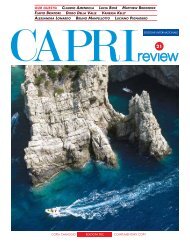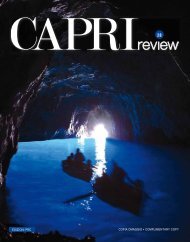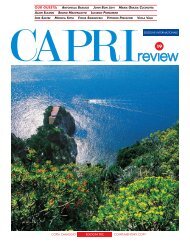Create successful ePaper yourself
Turn your PDF publications into a flip-book with our unique Google optimized e-Paper software.
La villa, situata nella parte<br />
antica di Anacapri,<br />
risale al XVII secolo.<br />
Colette’s villa, located<br />
in the old part of Anacapri,<br />
dates back to the 17th century.<br />
opere come Ces Plaisirs… e Chéri raggiungono<br />
diverse migliaia di copie, mentre<br />
i suoi servizi giornalistici sono attesi<br />
da sempre più numerosi ammiratori entusiasti.<br />
Nel luglio del 1915 torna in Italia, questa<br />
volta come inviata speciale del giornale<br />
Le Matin. Da Lugano raggiunge<br />
Venezia e successivamente Roma. Come<br />
nella sua prima visita, continua ad annoiarsi.<br />
Trova la città stranamente ferma<br />
nel tempo e lontana, anche allora<br />
che si era in tempo di guerra. Decide, allora,<br />
di ritornare a <strong>Capri</strong>. Qui raggiunge<br />
Anacapri e va direttamente a via Timpone,<br />
dove contratta l’acquisto della casa<br />
scoperta cinque anni prima.<br />
In poche settimane i vecchi muri dalle<br />
volte a vela riprendono vita. Colette<br />
adesso è ricca ed è tra i più grandi<br />
▼<br />
both male and female lovers<br />
after her relationship with<br />
Missy broke up.<br />
After losing her amour, Colette<br />
found herself having to earn<br />
her living, and decided to<br />
embark on a career in the<br />
theatre, performing as a<br />
dancer and mime at the<br />
leading Parisian music halls,<br />
together with the already<br />
famous Polaire. During those<br />
years she promoted the myth<br />
of herself as a liberated<br />
woman, who shared herself<br />
with many lovers, in the belief<br />
that “the senses are a source<br />
of power in the human body.”<br />
And she unashamedly showed<br />
off her own body, even<br />
exposing her breasts,<br />
welcoming “every kind of<br />
forbidden experience” and<br />
creating a scandal.<br />
Her visit to Italy in 1910<br />
marked a turning point and the beginning of a<br />
new stage in her life.<br />
The trip was a gift from her young admirer<br />
Auguste Heriot, son of a very wealthy<br />
Parisian family that owned the Grand<br />
Magasins du Louvre. Heriot had courted her,<br />
invited her to the best restaurants in Paris and<br />
showered her with gifts, and now he hoped to<br />
win her heart forever by inviting her on this<br />
holiday.<br />
They had just arrived in Italy in mid-July,<br />
when Colette was informed that her divorce<br />
had become final. Now, after years of being<br />
eclipsed, she was free not only to reveal that<br />
she was the author of the Claudine series, but<br />
to publish under her own name Le<br />
Vagabonde, the novel that was serialized in<br />
the magazine La Vie Parisienne.<br />
She was bored during their stay in Rome,<br />
finding the city empty and too quiet. She<br />
spent whole afternoons walking her dogs in<br />
the Villa Borghese or on the deserted slopes<br />
of the Palatine Hill. To her, the city seemed to<br />
be asleep, despite its myriad colours and<br />
atmospheres. So she decided to go south,<br />
and Heriot followed her reluctantly.<br />
In November, they reached Naples and the<br />
Amalfi coast, from where she sent brief letters<br />
home: “My dear Mother, we are having lunch<br />
in Positano, in a country that is too beautiful to<br />
be true.” And the next day: “I was dazzled<br />
when I arrived here. I have to confess that the<br />
Bay of Naples lives up to its reputation.”<br />
If truth be told, the journey tired her and she<br />
experienced considerable discomfort, but the<br />
constant discoveries, the light, the scents and<br />
the uncontaminated scenery captivated her<br />
senses and her mind. She wrote few notes,<br />
sent only short messages to reassure her<br />
mother and “put up with” her dispirited travelling<br />
G.B. BRAMBILLA - NERI<br />
companion’s advances. In actual fact, her young<br />
and inexperienced beau bored her, as she<br />
confided to her friend Léon Hamel: “I’m never<br />
going to manage to write a letter. Today boat,<br />
carriage, boat, storm.” In other words, it was a<br />
“tour de force” with a friend who was no fun.<br />
Despite the unpredictable weather, the rain<br />
and the rough sea, she decided to go on to<br />
<strong>Capri</strong>. She didn’t have a pleasant trip, because<br />
the rocking of the boat made her seasick. But<br />
when she sailed along the coast of the island<br />
of Procida, she forgot everything and went into<br />
raptures over the magnificent gardens that<br />
were “so old, and filled with roses and orange<br />
groves”. But the sea got rougher and she<br />
started feeling seasick again. Finally they<br />
docked at <strong>Capri</strong>. Colette was completely spellbound<br />
by its beauty. She was seized with<br />
tremendous energy, and in just a few days she<br />
had seen everything, travelling the length and<br />
breadth of the island without stopping. She<br />
wanted to see every single thing, immerse<br />
herself in the island’s atmosphere, get to know<br />
its history, and the people. She became more<br />
and more excited, and went to visit one of the<br />
now legendary sites: “I am off to the Blue<br />
Grotto, which you go into through a tiny<br />
entrance and where everything is illuminated<br />
by a phosphorescent and unforgettable blue<br />
light,” she wrote, enthralled. The blue island<br />
had captured her heart for ever.<br />
Colette then started going for long walks along<br />
the more isolated, quieter roads. And it was at<br />
Anacapri that she found her new house. In the<br />
street that is now known as Via Timpone, she<br />
spotted some old eighteenth-century buildings<br />
that were part of the San Michele monastery<br />
complex. Colette fell in love with the place at<br />
first sight, but told no one how much she<br />
wanted the property, not even her increasingly<br />
miserable and desperate companion.<br />
Her stay on <strong>Capri</strong> ended soon after, as did her<br />
liaison with Heriot – which had never really<br />
come to anything – whose character she<br />
described most insightfully to her confidant<br />
Hamel: “My young companion sends his<br />
greetings. He’s very kind when he’s alone with<br />
me, but he’ll never be happy; it’s as if his<br />
personality were rooted in sadness.”<br />
When she returned to Paris in December she<br />
met Henry de Jouvenel, co-editor of the<br />
newspaper Le Matin and her future husband.<br />
She married him in July 1913, three months<br />
after her beloved Sido died. They had a baby<br />
girl, who was named after Colette’s mother.<br />
Colette was now becoming the leading light of<br />
Parisian literary circles. Her books, including<br />
the Claudine series and new works such as<br />
Ces Plaisirs… and Chéri, sold thousands of<br />
copies, and her newspaper articles enjoyed an<br />
ever-wider enthusiastic readership.<br />
In July 1915 she returned to Italy, this time as<br />
Le Matin’s foreign correspondent. From<br />
Lugano she went to Venice and then on to<br />
Rome, where she was bored again. She felt ▼<br />
45







